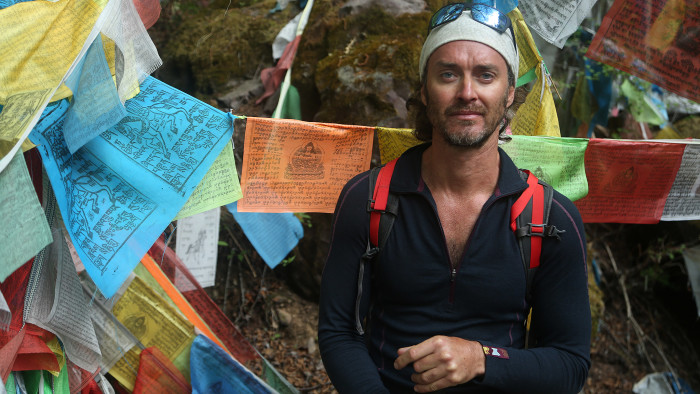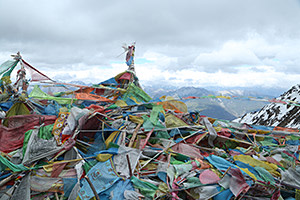The Canadian adventurer who settled in China’s ‘Shangri-La’

Simply sign up to the Life & Arts myFT Digest -- delivered directly to your inbox.
For most people, a love of mountains might lead them to a holiday chalet in the higher reaches of a smart Alpine resort. For Canadian-born Jeff Fuchs, 46, whose childhood in Ottawa was punctuated by stints in Geneva, it has resulted in a journey halfway around the world, to set up home in the shadow of the Himalayas: an area of China’s northwest Yunnan province that borders Tibet.
Fuchs, 46, defies easy categorisation, with his multifarious interests coalescing along his path to Shangri-La: writer, photographer, mountaineer, explorer, connoisseur and merchant of teas. He attributes much of his free spirit to the influence of his Hungarian grandmother. “She was fearless, emotional and believed that no one had the right to disturb a good meal or drink,” he says.
At high school in Ottawa, says Fuchs, his tendency to question anything too doctrinaire led to a run-in with his religious studies teacher, prompting him to quit prestigious St Pius (“which caused a bit of a scandal”) and complete his schooling elsewhere, before heading to Montreal to study photography. At the same time, his father and grandmother encouraged him to engage in activities “that got the blood activated”, inspiring his love of the outdoors.
His first encounter with the mountains was in Switzerland, at the age of four. “Then, when I was 15, I worked in a lodge in the Rockies and took my days off to explore and climb. I knew at that point that I’d need mountains close to me for the rest of my days. Climbing and ascending was some sort of strange panacea.”
He developed a fascination for the Himalayas, and “an obsession” with anthropology and mountain peoples. He also became “infected with the tea bug”, picked up in a home where Asian food and philosophy formed part of his early diet. His father had a life-long fascination with the region but never managed to travel there.
In 1999 Fuchs set off for Asia and settled in Taiwan where he was taught about Camellia sinensis, the plant used to make tea, by one of the island’s leading tea families. He travelled in search of growers and rare teas, which led to him filming a documentary about the Lukai, an indigenous people of Taiwan.
In 2003 Fuchs visited China’s northwest Yunnan province to climb. Formerly known as Zhongdian, the area was officially renamed Shangri-La in 2001 by the Chinese government, after the utopia featured in James Hilton’s book Lost Horizon, which was allegedly set in the region. Both a county and a town, its monasteries, architecture and local culture reflect the approximately 80 per cent Tibetan population of the region.
“It wasn’t a China I’d seen much written or spoken of,” he says. “It had tea and mountains, which were, and still are, my two passions. That’s when I heard the tale of the Tea Horse Road which stretched through Yunnan’s length and up into Tibet and beyond . . . and the idea to travel the route from end to end became a fixed thought.”

The Tea Horse Road – like the Salt, Wool or Silk Roads – was one of many ancient trade routes, disused since the 1950s, which snaked through the Himalayas. Two years later, Fuchs moved to Shangri-La in his bid to become the first westerner to trek the entire 6,000km route.
At that time foreigners were few, “beyond a smattering of missionaries from the US”, and finding somewhere to live was – as still is – a matter of talking to local people. Fuchs eventually found an abandoned Tibetan home, and negotiated a year’s lease. “It was bare bones with wooden planks, and windows which welcomed in the winds,” he laughs.
Today, Fuchs lives in the attic of a house built by a friend, in the “old Tibetan style” with large windows overlooking a temple. “I need space, light and a minimum of clutter . . . except for a ridiculous pile of tea and mountain kit,” he says. The latter has been used, to date, on five major expeditions along the trade routes of the Himalayas, the longest of which was a 7.5-month trek along the Tea Horse Road. The gruelling journey, the hospitality of local people and the oral narratives shared by the elders Fuchs met are recounted in his 2008 book The Ancient Tea Horse Road. “These mountain routes transported so much more than simply commodities,” he says. “They transferred cultures, plant matter, DNA, linguistics . . . making the mountains far richer in life and history than many might think.”
When not planning expeditions, he unwinds by socialising with friends. “Tibetans, Lisu, Bai, and Yi along with a few foreigners who come through yearly and have rented homes.” Fuchs speaks warmly of the generosity of the local people. The fact he speaks Mandarin and a local Tibetan dialect helps.
He says he occasionally visits Europe, North America and other parts of Asia for a change of scene, as well as to fundraise, lecture and visit friends. “I need to get out of the mountains to ensure I don’t entirely fold into them,” he says.
In an area suffering from intermittent electricity, sketchy WiFi and an unreliable water supply, nothing can be taken for granted. “Luxury,” says Fuchs, “is a wood stove puffing out heat, and some tea.”
In January, a devastating fire destroyed 75 per cent of the Old Town, and the influx of businessmen from other parts of China in recent years threatens to destroy what is left of the region’s unique character. “Speed is creeping into the area. Speed of decision making, of building, of development,” says Fuchs, who adds that property values have risen twentyfold in just six months.
As for the future, Fuchs is keeping an open mind. “Shangri-La will not be home forever, but rather it will become a home away from home and there are no plans to return to Canada permanently. Yunnan is in the blood, though, very much.”
——————————————-
Inside knowledge
Pros
● Clean air
● Spectacular scenery
● Small-town community spirit
Cons
● Frequent water and power cuts
● Very few amenities
● Remote location makes travelling elsewhere difficult
● Seasonal influx of tourists
Trekking the Sho-La pass A highlight of the Tea Horse Road
Al-fresco dining Fuchs’ favourite picnic spot is in a little sandalwood forest near Shika mountain just west of Shangri-La
Tara’s Gallery restaurant A tea shop run by an Indian woman who was the first foreigner allowed to stay in the region
——————————————-
Buying guide
The property market in Shangri-La is in its infancy, with changing laws and little infrastructure. Property tends to change hands informally through middlemen. Prices are rising steeply, however, especially in the Old Town
What you can buy for . . .
$500,000 A 20-year lease on a large old Tibetan home
$1m A four-floor, 1,200 sq metre house on the edge of the Old Town
Photographs: Andrew Gregg
Comments